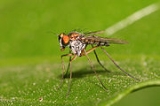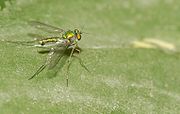
Dolichopodidae
Encyclopedia
Dolichopodidae, the long-legged flies, make up a large family of true flies
with more than 7,000 described species
in about 230 genera
distributed worldwide. The genus Dolichopus
is the most speciose, with some 600 species. They are generally small flies with large, prominent eyes and a metallic cast to their appearance, though considerable variation is observed. Most have long legs, though some do not. The males often have enlarged genitalia which can be useful for species recognition. The adults are predatory
on other small animals.
This family includes the subfamily Microphorinae, formerly placed in Empididae
, and briefly considered a separate family.
e occupy a wide range of habitats, both terrestrial and aquatic, and can be predators or scavenger
s.
deposits throughout the world and the group has clearly been well distributed since the Cretaceous
at the latest. Together with the Empididae
they are the most advanced members of the Empidoidea
. They represent the bulk of Empidoidea diversity, containing more than two-thirds of the known species
in their superfamily
.
Internal relationships of the Dolichopodidae and their delimitation versus the Empididae are not yet resolved to satisfaction. It is likely that the considerable number of subfamilies is subject to change.


Diptera
Diptera , or true flies, is the order of insects possessing only a single pair of wings on the mesothorax; the metathorax bears a pair of drumstick like structures called the halteres, the remnants of the hind wings. It is a large order, containing an estimated 240,000 species, although under half...
with more than 7,000 described species
Species
In biology, a species is one of the basic units of biological classification and a taxonomic rank. A species is often defined as a group of organisms capable of interbreeding and producing fertile offspring. While in many cases this definition is adequate, more precise or differing measures are...
in about 230 genera
Genera
Genera is a commercial operating system and development environment for Lisp machines developed by Symbolics. It is essentially a fork of an earlier operating system originating on the MIT AI Lab's Lisp machines which Symbolics had used in common with LMI and Texas Instruments...
distributed worldwide. The genus Dolichopus
Dolichopus
Dolichopus is a large cosmopolitan genus of fly in family Dolichopodidae. Adults are small flies, typically less than 8 mm in length. Nearly all species are metallic greenish-blue to greenish-bronze. It is the largest genus of Dolichopodidae with more than 600 species...
is the most speciose, with some 600 species. They are generally small flies with large, prominent eyes and a metallic cast to their appearance, though considerable variation is observed. Most have long legs, though some do not. The males often have enlarged genitalia which can be useful for species recognition. The adults are predatory
Predation
In ecology, predation describes a biological interaction where a predator feeds on its prey . Predators may or may not kill their prey prior to feeding on them, but the act of predation always results in the death of its prey and the eventual absorption of the prey's tissue through consumption...
on other small animals.
This family includes the subfamily Microphorinae, formerly placed in Empididae
Empididae
Empididae is a family of flies with over 3,000 described species occurring worldwide, but the majority are found in the Holarctic. They are mainly predatory flies like most of their relatives in the Empidoidea, and exhibit a wide range of forms but are generally small to medium sized, non-metallic...
, and briefly considered a separate family.
Ecology and behaviour
Dolichopodidae give visual (as distinct from chemical or other) signals during courtship; many studies have been undertaken of this behavior. The larvaLarva
A larva is a distinct juvenile form many animals undergo before metamorphosis into adults. Animals with indirect development such as insects, amphibians, or cnidarians typically have a larval phase of their life cycle...
e occupy a wide range of habitats, both terrestrial and aquatic, and can be predators or scavenger
Scavenger
Scavenging is both a carnivorous and herbivorous feeding behavior in which individual scavengers search out dead animal and dead plant biomass on which to feed. The eating of carrion from the same species is referred to as cannibalism. Scavengers play an important role in the ecosystem by...
s.
Evolution and systematics
Dolichopodids are well represented in amberAmber
Amber is fossilized tree resin , which has been appreciated for its color and natural beauty since Neolithic times. Amber is used as an ingredient in perfumes, as a healing agent in folk medicine, and as jewelry. There are five classes of amber, defined on the basis of their chemical constituents...
deposits throughout the world and the group has clearly been well distributed since the Cretaceous
Cretaceous
The Cretaceous , derived from the Latin "creta" , usually abbreviated K for its German translation Kreide , is a geologic period and system from circa to million years ago. In the geologic timescale, the Cretaceous follows the Jurassic period and is followed by the Paleogene period of the...
at the latest. Together with the Empididae
Empididae
Empididae is a family of flies with over 3,000 described species occurring worldwide, but the majority are found in the Holarctic. They are mainly predatory flies like most of their relatives in the Empidoidea, and exhibit a wide range of forms but are generally small to medium sized, non-metallic...
they are the most advanced members of the Empidoidea
Empidoidea
The Empidoidea are a large monophyletic superfamily of true flies, the sister taxon to the Muscomorpha . These two groups are sometimes united in the unranked taxon Eremoneura...
. They represent the bulk of Empidoidea diversity, containing more than two-thirds of the known species
Species
In biology, a species is one of the basic units of biological classification and a taxonomic rank. A species is often defined as a group of organisms capable of interbreeding and producing fertile offspring. While in many cases this definition is adequate, more precise or differing measures are...
in their superfamily
Taxonomic rank
In biological classification, rank is the level in a taxonomic hierarchy. Examples of taxonomic ranks are species, genus, family, and class. Each rank subsumes under it a number of less general categories...
.
Internal relationships of the Dolichopodidae and their delimitation versus the Empididae are not yet resolved to satisfaction. It is likely that the considerable number of subfamilies is subject to change.
See also
List of dolichopodid genera

External links
- Bug Guide images
- Diptera.info images
- Igor Grichanov Dolichopodidae home page
- Family description
- Family description
- University of Lille Multi-imaged site. Whole specimens and parts.
- Palaearctic species list
- Nearctic species list
- Australasian and Oceanian species list
- Japan species list
- Video of sciapodine of Texas

